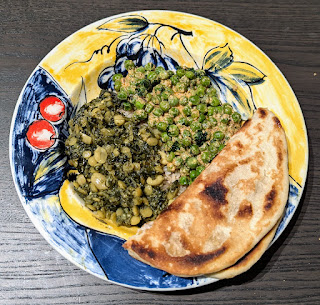I already have quite a few banana bread recipes. That said, just because I have a bunch of good ones already, doesn't mean I'm not interested in trying even more!
Today was my first day in New Zealand. (I mean, not actually today-today. Not June 28th when this recipe is posted, but December 30th when I'm actually writing from.) I arrived in Hamilton yesterday and today was my first full day here. I woke up good and early due to the time change and decided that it would be nice to make use of the time and make something tasty for breakfast for everyone else to wake up to. That said, being my first day here, I hadn't had a chance to do a grocery shop yet or get a good handle on what was in the kitchen. But I knew that there were a bunch of bananas, eggs, sugar, and flour, so I figured that was a pretty good start.
I did end up making a few tweaks to the recipe. All-purpose flour isn't really a thing here, so I used a mix of "high grade" (hard) and "standard" (soft) flour. There wasn't any plain yogurt, just manuka honey yogurt, so I rolled with that but then halved the sugar. The bananas and eggs were both on the small side, so I threw an extra of each in. And since unsalted butter doesn't really seem to be a thing here, so I just used the salted and then omitted the salt from the recipe. I also ended up swapping out the walnuts for a mix of chocolate chips and sunflower seeds, since there didn't appear to be any walnuts in the pantry. And, as it turns out, that worked out quite well since Reiver doesn't really care for walnuts in his banana bread
1 and ended up quite liking the sunflower seeds.
Banana Bread
Adapted from The Breakfast Bible by Kate McMillan
Ingredients
- 2 1/4 c. all-purpose flour2
- 1/2 c. sugar
- 1 tsp. baking soda
- 4 very ripe bananas, mashed
- 2 large (or 3 medium) eggs
- 1/3 c. manuka honey Greek yogurt3
- 1/2 c. salted butter4, melted
- 1 tsp. vanilla extract
- 1/2 c. chocolate chips and/or chopped walnuts
- 2-3 Tbsp. sunflower seeds (or more walnuts)
Directions
- Preheat oven to 180°C (350°F) and grease and flour a 23x13cm (9x5") loaf pan.
- Combine the flour and sugar, sift in the baking soda, and mix well.
- Mash the bananas.
- Beat the eggs into the bananas and stir in the yogurt, butter, and vanilla.
- Stir in the chocolate chips and/or walnuts.
- Pour the batter into the prepared tin and sprinkle with the sunflower seeds.
- Bake at 180°C (350°F) for ~1 hour.
- Transfer to wire rack to cool for 10 minutes.
- Turn out of tin and allow to finish cooling on the cooling rack.
Although I did later find out that apparently part of the reason he preferred the sunflower seeds was that they are smaller than walnuts. Which initially confused me since I usually chop my walnuts to about the same size as sunflower seeds or chocolate chips. But apparently that's not the norm here and people typically just toss whole walnut halves into their baked goods! (New Zealand is a strange place.)
Back
I used 2 c. of hard flour and 1/4 c. of soft flour for mine.
Back
I also think that plain yogurt, either Greek or not, would probably work fine here. Your bread will be a little less sweet if you're using plain yogurt, but I still think that it would be sweet enough. And, if you find it's not, you can always add a bit more sugar.
Back
Or unsalted butter + 1/2 tsp. coarse sea salt.
Back












